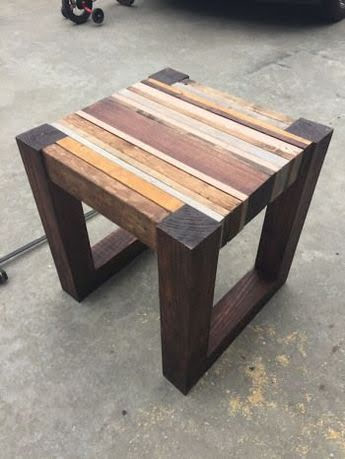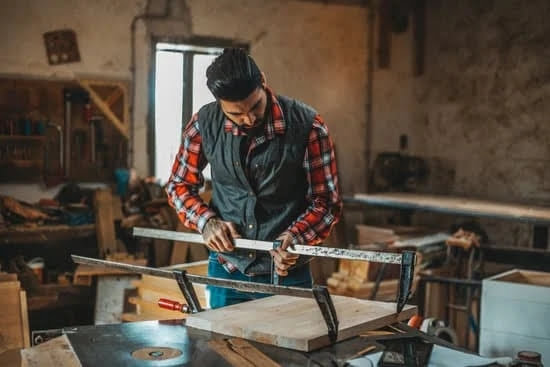Introduction to Woodworking
Woodworking is a craft that has been around for centuries. It involves the use of many different tools and techniques to create beautiful, functional pieces from wood. With woodworking you can make furniture, shelves, toys, art and much more! Not only do you get to work with your hands, but it’s also a great way to express yourself creatively. The benefits of woodworking are numerous. You get to take pride in the piece that you create no matter how big or small it may be. Additionally, the process requires patience and attention to detail which can improve cognitive skills. Furthermore, by learning how to build something from scratch you can save money buying it ready-made at a store. Finally, there’s something very rewarding about seeing a creation of yours take shape with your own two hands!
An Overview of the Different Types of Woodworking
Woodworking is a craft that involves the shaping and crafting of wood to create items such as furniture, cabinets, doors, toys, sculptures, and more. It’s an incredibly rewarding activity that produces great results when done correctly. There are numerous types of woodworking to choose from, so it’s important for each individual to determine which one appeals to them the most.
Carpentry is one of the oldest and most basic forms of woodworking. It includes the cutting and building of structural components like floors, walls and frames out of wood. In contrast to this, solid-wood joinery is similar but more intricate because it requires the use of hand tools such as chisels and saws instead of just nails or screws. Furniture making is another type where pieces are carefully crafted by assembling pieces together in a very precise manner while also taking into account aesthetics.
Turning is a type of woodworking which involves spinning pieces on a lathe in order to create beautiful designs that range from bowl shapes to candlesticks and sculptures with complex patterns. Scroll work focuses on scroll saw patterns etched into various wooden objects; this often requires cutting many different angles depending on the desired pattern.
Carving requires carving sculptural forms from blocks or turnings; not only does the carver create beautiful artwork but also can shape functional items such as spoons or chairs. Finally, cabinetmaking is an advanced practice where cabinetry fixtures are created using various joinery techniques with intricate details and miter cuts being involved in the creation process. All these different types provide ample opportunities for those interested in learning how to do woodworking!
Woodworking Tools and Supplies
Woodworking is a wonderful hobby for anyone to get into, and it can be done with just a few simple tools. While you can find ready-made lumber at many home improvement stores, the cost of these materials may add up quickly. To save money and keep yourself safe, consider buying essential woodworking supplies from specialized stores or online vendors. When purchasing woodworking supplies, look for high-quality products that are durable and sturdy. Some of the must-have items include:
1. Power Tools: A good assortment of power tools is vital for any woodworking project. The most popular types of power tools used in woodworking include circular saws, drills, routers, sanders, lathes, jointers and planers. Choose an electric saw or drill that best suits your projects’ needs in terms of type, size, cutting speed and power model. Make sure all electrical cords and plugs are rated at the right voltage for your specific job.
2. Hand Tools: There are some woodworking tasks that require precise hand movement rather than power tools. You should purchase a variety of basic hand tools like chisels and screwdrivers as well as more advanced items such as planes and specialised blades like coping saws or dovetail saws if you want to get into furniture making projects in the future.
3. Safety Gear: Safety should always be considered when working on DIY projects and so it’s important to buy appropriate safety gear for yourself such as goggles and earmuffs to protect yourself from flying debris or dangerous noise levels respectively; moreover it might also not be a bad idea for you to pick up some gloves instead if your chosen materials may contain splinters like balsa wooden boards do .
4. Adhesives & Glue Gun: Wood glue is one of the mainstay materials used when bonding pieces together tightly; other glues like epoxy resin can create stronger bonds between certain surfaces which protects against wear & tear; meanwhile glue guns provide strong hold adhesives that have proven useful in many situations – especially crafts projects that are sometimes tricky without them!
Woodworking Skills
Learning the basics of woodworking can be a daunting proposition for some, but with the right tools and attitude, anyone can start to make beautiful and useful pieces from lumber. Before starting out, it is important to understand the tools that are needed to work with wood and their proper use. A good quality saw is essential for cutting lumber to size; hand saws are great for smaller projects and most beginner’s kits contain one. A jigsaw is great for intricate designs and curved shapes but requires much more finesse than a standard saw. Other tools that are necessary are a hammer, chisels, clamps, drill bits and a workbench or table. Additionally, basic knowledge of sanding techniques should be acquired as well as how to join two pieces of wood together without breaking them. Woodworking in itself is an art and practice is key in order to create beautiful pieces. However, with the right set up such as adequate lighting and workspace, along with taking safety precautions such as wearing eye protection, novice woodworkers can start making wonders all by themselves! Learning how to do the right finishing touches on projects such as staining or varnishing enhances their beauty even further. With patience and dedication one eventually learns how to handle various types of wood which might require different approaches. Knowing which type of joinery works best for a specific design also requires plenty of research since every project has its own challenges. Finally mastering skills such as routing or carving can open many more possibilities for would-be craftsmen who wish to push further boundaries of their craftsmanship
Woodworking Projects For Beginners
Woodworking is a great hobby for any creative person who enjoys working with their hands. With the right tools and some dedication, there are plenty of woodworking projects that beginners can make. Projects range from simple birdhouses to sophisticated furniture like dressers or desks. Depending on your level of expertise, you can start with easier projects or challenge yourself by trying something more complicated. For instance, those new to woodworking can try building a basic bookcase or outdoor bench while more experienced crafters may want to attempt making a wooden jewelry box or toy chest. Additionally, you could even learn how to build your own mini kitchen island or barstool. No matter which project you choose, if done properly you will end up with something beautiful that is sure to be admired and appreciated by family and friends alike.
Troubleshooting Common Challenges When Woodworking
Learning to do woodworking is an exciting hobby that can open a world of creative possibilities. Woodworking comes with its challenges, however. Knowing how to troubleshoot common problems and issues can save you valuable time and energy while woodworking.
One common problem you may run into while woodworking is a board becoming bowed in the center, which happens when wood is braced too tightly or not evenly divided among clamps. If this happens, you’ll need to release some of your clamps and add more on each side of the middle section as needed until the board is straightened out.
Another problem might be when a joint doesn’t fit properly, often caused by inaccurate measurements or marking up lines. To fix this, use sandpaper along edges from both pieces and alleviate any loose material until the joint locks into place. For matters related to staining your projects or finishing them off, like paint chipping off or leaving streaks, sand down the part again before adding another coat for better results.
You should always refer to specific instructions for each project before starting it to avoid these mistakes but troubleshooting them as best as you can will give you improved results from your work every time!
Safety Tips for Woodworking
Safety should always be the priority when it comes to woodworking. Here are some important tips and considerations to keep in mind:
• Wear proper clothing and protective gear such as closed-toe shoes, gloves, safety glasses, and a dust mask.
• Use the appropriate tools for the job. Make sure all your saws, planers, drills, sanders, and routers are up to date and in good working order.
• Keep your work area clean and clutter-free by sweeping or vacuuming regularly. Remove any sawdust with a shop vacuum or air compressor.
• When cutting wood use a clamp or vice to secure the material being cut to avoid potential injuries.
• Measure twice, cut once! Double check your measurements before you make any cuts or apply finishing touches.
• Always unplug machines when not in use to reduce the chance of electric shock or fire hazard.
• Finally – if you ever feel unsure about what you’re doing – don’t hesitate to stop and ask for help from an experienced woodworker!
Tips on Finishing and Sealing Woodworking Projects
Wood finishing and sealing is a crucial part of woodworking. Properly finishing and sealing woodworking projects not only makes them look professional and attractive, but also helps to protect them from damage due to rain, water, heat, UV rays, and other environmental factors.
Here are some essential tips for completing your woodworking project with a successful finish:
1.Make sure the surface is thoroughly cleaned before starting work. Dust and dirt will reduce the effectiveness of the finishing coat, so ensure that all particles are removed before beginning.
2. Identify the type of material you are working with (e.g., hardwood, softwood). Different types of wood need different types of finishes for best results.
3. Sand your project lightly before beginning any sealant applications—it’s important to create an even surface for maximum adhesion of the finish or sealant. Start by sanding with fine-grit sandpaper and gradually increase the coarseness until the desired finish has been achieved.
4. Consider a primer before applying any sealant or paint to your project—this ensures better adherence of the topcoat and provides additional protection against moisture damage or staining.
5. Select a sealer or finish that’s best suited for your type of project (i.e., outdoor furniture or cabinets indoors). Remember that sealants can deteriorate over time if exposed to harsh weather conditions or UV radiation, while finishes provide more long-term protection against these damages while adding shine and color to the woodwork.
6. Practice safety when applying finishes or sealants; wear protective gear such as gloves, long sleeves, and dust masks/respirators if necessary to avoid direct contact with fumes or liquid products when spraying on surfaces!
Advanced Woodworking Skills
Woodworking is not only a rewarding and satisfying hobby but it can also lead to lucrative and exciting career opportunities. Learning the fundamentals of woodworking is essential for anyone that desires to delve into the world of woodworking, and these fundamental skills will serve as a platform from which you can rapidly increase your knowledge and take your woodworking projects to advanced levels. There are several steps you can take to learn how to do woodworking at an advanced level, such as taking classes in advanced carpentry techniques, joining a woodworking club or association, subscribing to an online training program, and studying books about different types of projects.
Taking classes in advanced carpentry techniques can help you deepen and refine the fundamental skills that you have acquired. In most cases, these classes will require a certain amount of time in order to be completed, so they are best suited for those with prior experience in woodworking or a strong commitment to learning new skills. Depending on the class you take, topics may include mastering joinery techniques like dovetails and mortise-and-tenon joints; understanding how different grain patterns work when cutting; making precise cuts; constructing cabinets; building furniture with drawer box construction; and so much more.
Joining a local or regional woodworking club or association is another way that enables people to connect with like-minded individuals who share similar interests in working with their hands. Here you will have access to knowledgeable professionals who can answer any questions you might have while also keeping up with the latest trends and designs being used today. Plus, many clubs offer workshops where members can sharpen their skills while sharing ideas on all kinds of projects.
Subscribing to an online training program or course takes knowledge acquisition one step further by offering specialized instruction tailored specifically towards what topics interest you most. These programs often focus on teaching specific skillsets related to joinery and/or building furniture pieces made from solid‑wood components. They offer helpful information for handling all types of woods effectively – from softwoods like pine through hardwoods like cherry – as well as demonstrating how experienced woodworkers approach complex joinery methods through clear instructional videos supported by downloadable plans for each project along with helpful notes from instructors.
Finally, there’s no substitute for reading books about different types of projects – old ones as well as modern ones – which provide valuable guidance on how experienced craftsmen go about creating beautiful works of art out of simple pieces of raw material such as wood boards lumbers or plys. Reading these books provides insight into different design concepts while giving readers an opportunity see what has been done before enable them create something new out of it later down line instead of just replicating furniture pieces found somewhere else.. With each book covering different aspects such as selecting diverse species hardwoods designing legs chairs connecting multiple components together many other related subject matter readers gain deeper understanding different procedures approaches incorporated applying come up their very own creative style work give end product even greater sense personal satisfaction than would otherwise been possible without these invaluable resources at one’s disposal..
The Perks of Learning to Do Woodworking
Learning to do woodworking can open up a wealth of possibilities for any kind of handy person. Woodworking is not only a rewarding hobby, but it also has the potential to provide you with a profitable side hustle or even a full-time job. From creating furniture and cabinets to smaller woodworking projects like birdhouses or picture frames, there’s plenty of opportunity to explore with this helpful skill. With the right tools and materials on hand, you can make virtually anything out of wood!
When learning how to do woodworking, the first step is understanding carpentry basics. This can involve everything from reading up on certain techniques such as sawing and drilling to selecting the right types of woods and lumber for your project. You’ll also want to become familiar with tools such as circular saws and hand drills common to most carpenters’ toolboxes. Once you feel comfortable with these basics, take some time to experiment on small projects that allow you to practice and hone your skills.
Only once you have built up knowledge through trial-and-error will you be able to properly execute more complex designs, whether that be recreating antique furniture pieces or even constructing entirely new home additions. When you begin creating things out of woodworking plans or using your own vision, there really are no limits – which is why it pays off so much in the long run if taken seriously as a skill or craft. With thorough research and dedication when learning how to do woodworking, soon enough you’ll reap the rewards for yourself too!
Conclusion
Learning how to do woodworking is an incredibly rewarding experience. Not only will you have the satisfaction of being able to create something beneficial and beautiful with your own hands, but you will also gain important skills and knowledge that can be used in many other aspects of your life. Woodworking is an activity that requires concentration, patience, and a creative eye – all qualities necessary for success in most endeavors. With the right tools and guidance from an experienced instructor, it is easy to become adept at creating stunning works of art from wood. Whether you want to make furniture or build structures for your home, learning this skill can help you achieve great results. So why not give it a try – you never know what incredible creations might await!

Hi everyone! I’m a woodworker and blogger, and this is my woodworking blog. In my blog, I share tips and tricks for woodworkers of all skill levels, as well as project ideas that you can try yourself.





